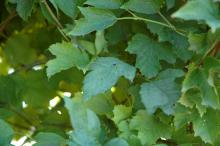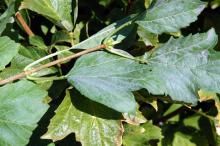Cause Powdery mildew on Viburnum spp. is caused by multiple different fungal species including Erysiphe miranda, E. vibruni, E. pseudoviburni, and E. viburniphila. Only E. viburniphila and E. vibruni have been reported in the Pacific Northwest. Erysiphe viburniphila was described from the Pacific Northwest on the non-native, ornamental plant, Viburnum tinus, and the Pacific Northwest native species, Viburnum edule. Erysiphe viburniphila is also known to occur on other North American native species from the east coast such as Viburnum bracteatum, V. pubescens, and V. rafinesqueanum. Erysiphe viburni has only been reported on Viburnum opulus and Viburnum edule in the Pacific Northwest.
Symptoms The disease primarily affects young leaves and shoots. Affected plant tissues develop a powdery white growth of fungal mycelia. The fungus can be found on either leaf surface. Tiny black specks (cleistothecia) may be observed among the white mycelia in late summer. Developing leaves may be somewhat deformed by severe infections.
Cultural control
- Plant in full sun.
- Plant resistant varieties such as Viburnum burkwoodii 'Mohawk' and V. carlecephalum 'Cayuga'.
- Rake and destroy fallen leaves.
- Remove and destroy heavily infected leaves and shoots.
- Space plants and prune to provide good air circulation.
Chemical control Do not use sulfur products (such as Safer's Garden Fungicide); they cause black spots on leaves and defoliation. Fungicides will do best when used before symptoms develop. Few materials have good eradicant activity. Use at 7- to 14-day intervals; using shorter intervals when environmental conditions favor disease development. Alternate or tank-mix products from different groups that have different modes of action. Limit the use of any one group during crop production.
- Armada 50 WDG at 3 to 9 oz/100 gal water. Do not use a silicone-based surfactant. Not for nursery or greenhouse use. Group 3 + 11 fungicide. 12-hr reentry.
- Bicarbonate-based products. Might supplement a normal program when powdery mildew is first observed. Do not mix with acidifying agents. Thorough coverage is essential. O
- MilStop (85% potassium bicarbonate) at 2.5 to 5 lb/A. Oregon and Washington only. 1-hr reentry.
- Monterey Bi-Carb Old Fashioned Fungicide at 4 teaspoons/2 gal water H
- Broadform at 2 to 4 fl oz/100 gal water. Group 7 + 11 fungicide. 12-hr reentry.
- Daconil Weather Stik at 1.38 pints/100 gal water. May not be too effective. Group M5 fungicide. 12-hr reentry.
- Eagle 20 EW at 6 to 12 fl oz/100 gal water. Group 3 fungicide. 24-hr reentry.
- Heritage at 1 to 4 oz/100 gal water plus a non-silicone-based wetter sticker. Group 11 fungicide. 4-hr reentry.
- Insignia SC at 3 to 6 fl oz/100 gal water. Do not use with organosilicate-based adjuvants. Use preventively only. Group 11 fungicide. 12-hr reentry.
- Myclobutanil 20 EW T&O at 6 to 12 fl oz/100 gal water plus spreading agent. May observe a PGR effect. Group 3 fungicide. 24-hr reentry.
- Orkestra at 6 to 8 fl oz/100 gal. Group 7 + 11 fungicide. 12-hr reentry.
- Pageant at 6 to 12 oz/100 gal water. Do not use with organosilicone-based adjuvants. Group 7 + 11 fungicide. 12-hr reentry.
- Seido at 4 to 5 fl oz/100 gal water plus an adjuvant. Group 50 fungicide. 4-hr reentry.
- Spectracide Immunox Multi-Purpose Fungicide Spray Concentrate for Gardens at 1 fl oz/gal water. Group 3 fungicide. H
Notes Do not use sulfur on viburnum as it can be phytotoxic.
Reference Bradshaw, M., Braun, U., Wang, S., Liu, S., Feng, J., Shin, H.D., Choi, Y.J., Takamatsu, S., Bulgakov, T.S. and Tobin, P.C. 2020. Phylogeny and taxonomy of powdery mildew on Viburnum species. Mycologia. 112:616-632.



